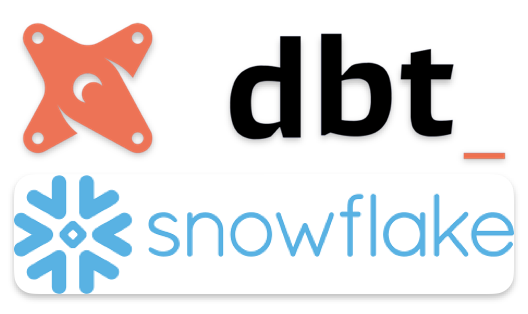dbt and Snowflake Integration
This article explores the integration of dbt with Snowflake, a comprehensive guide to using dbt with Snowflake. It covers the main concepts of dbt, including models, materializations, sources, tests, documentation, macros, and packages. It also discusses Snowflake-specific features like zero-copy cloning, time travel, and tasks. Additionally, it covers advanced concepts like incremental models, snapshots, seeds, and custom materializations. Finally, it provides best practices for using dbt with Snowflake.

DBT (Data Build Tool) and Snowflake Integration: A Comprehensive Guide
1. Introduction to dbt
dbt (Data Build Tool) is an open-source tool that enables data analysts and engineers to transform data in their warehouses more effectively. It’s designed to bring software engineering practices to the analytics workflow.
Key features:
- Uses SQL for transformations
- Adds modularity to SQL
- Provides testing framework
- Generates documentation
- Manages dependencies between models
2. Core Concepts
2.1 Models
Models are the core building blocks in dbt. They are essentially SELECT statements that transform your data.
Example:
-- models/customers.sql
SELECT
id,
first_name,
last_name,
email
FROM raw_customers
WHERE status = 'active'
2.2 Materializations
Materializations define how your models are created in the data warehouse. Common types:
- Table: Creates a new table with the results
- View: Creates a view
- Incremental: Allows for incremental updates to tables
- Ephemeral: Not directly created in the warehouse, but can be referenced by other models
Example:
{{ config(materialized='table') }}
SELECT * FROM ...
2.3 Sources
Sources define the raw data in your warehouse that your models build upon.
Example:
# models/sources.yml
version: 2
sources:
- name: raw_data
database: raw_db
tables:
- name: customers
- name: orders
2.4 Tests
dbt allows you to define tests for your models to ensure data quality.
Example:
# models/schema.yml
version: 2
models:
- name: customers
columns:
- name: id
tests:
- unique
- not_null
- name: email
tests:
- unique
2.5 Documentation
You can add descriptions to your models and columns, which dbt uses to generate documentation.
Example:
# models/schema.yml
version: 2
models:
- name: customers
description: "Cleaned customer data"
columns:
- name: id
description: "The primary key for customers"
- name: email
description: "The customer's email address"
2.6 Macros
Macros are reusable pieces of SQL that you can use across your project.
Example:
{% macro clean_stg_customers() %}
SELECT
id,
LOWER(email) as email,
COALESCE(first_name, 'Unknown') as first_name,
COALESCE(last_name, 'Unknown') as last_name
FROM {{ source('raw_data', 'customers') }}
{% endmacro %}
3. dbt and Snowflake Integration
3.1 Connection
To connect dbt to Snowflake, you need to provide the following details:
- Account
- User
- Password (or key pair authentication)
- Role
- Warehouse
- Database
- Schema
3.2 Snowflake-specific Features
3.2.1 Zero-Copy Cloning
Snowflake’s zero-copy cloning can be leveraged in dbt for creating dev environments:
{{ config(materialized='table', post_hook=[
"CREATE OR REPLACE TABLE {{ target.schema }}.{{ this.name }}_clone CLONE {{ this.name }}"
]) }}
SELECT * FROM ...
3.2.2 Time Travel
You can use Snowflake’s time travel feature in your dbt models:
SELECT * FROM {{ source('raw_data', 'customers') }} AT(OFFSET => -60*60)
This selects data as it was 1 hour ago.
3.2.3 Snowflake Tasks
While dbt doesn’t directly manage Snowflake tasks, you can create them as post-hooks:
{{ config(post_hook=[
"CREATE OR REPLACE TASK update_{{ this.name }} WAREHOUSE = transform_wh SCHEDULE = '60 MINUTE' AS CALL refresh_{{ this.name }}()"
]) }}
SELECT * FROM ...
3.3 Performance Optimization
3.3.1 Clustering Keys
For large tables, you can specify clustering keys:
{{ config(
materialized='table',
cluster_by=['date', 'customer_id']
) }}
SELECT * FROM ...
3.3.2 Query Tags
You can add query tags to help with monitoring and optimization:
{{ config(query_tag='daily_customer_update') }}
SELECT * FROM ...
4. Advanced Concepts
4.1 Incremental Models
Incremental models allow you to update your models with only the new or updated data, which can significantly improve performance for large datasets.
Example:
{{ config(materialized='incremental', unique_key='id') }}
SELECT * FROM {{ source('raw_data', 'customers') }}
{% if is_incremental() %}
WHERE updated_at > (SELECT MAX(updated_at) FROM {{ this }})
{% endif %}
4.2 Snapshots
Snapshots are used to track slowly changing dimensions over time.
Example:
{% snapshot customers_snapshot %}
{{
config(
target_database='analytics',
target_schema='snapshots',
unique_key='id',
strategy='timestamp',
updated_at='updated_at',
)
}}
SELECT * FROM {{ source('raw_data', 'customers') }}
{% endsnapshot %}
4.3 Seeds
Seeds are CSV files that you can include in your dbt project and reference in your models.
Example:
# data/country_codes.csv
country_code,country_name
US,United States
CA,Canada
UK,United Kingdom
You can then reference this in your models:
SELECT
c.*,
cc.country_name
FROM {{ ref('customers') }} c
LEFT JOIN {{ ref('country_codes') }} cc ON c.country_code = cc.country_code
4.4 Packages
dbt allows you to use and create packages to share code between projects.
To use a package, add it to your packages.yml:
packages:
- package: dbt-labs/dbt_utils
version: 0.8.0
Then you can use macros from the package in your models:
SELECT
{{ dbt_utils.generate_surrogate_key(['order_id', 'customer_id']) }} as surrogate_key,
*
FROM {{ ref('orders') }}
4.5 Custom Materializations
You can create custom materializations for specific use cases.
Example of a custom materialization that creates a table and a backup:
{% materialization table_with_backup, adapter='snowflake' %}
{%- set backup_table = this.incorporate(path=["backup"]) -%}
{%- set target_relation = this %}
{%- set existing_relation = load_relation(this) %}
{%- set backup_relation = load_relation(backup_table) %}
{{ run_hooks(pre_hooks) }}
-- Main table
{% call statement('main') -%}
CREATE OR REPLACE TABLE {{ target_relation }} AS (
{{ sql }}
);
{%- endcall %}
-- Backup table
{% call statement('backup') -%}
CREATE OR REPLACE TABLE {{ backup_relation }} CLONE {{ target_relation }};
{%- endcall %}
{{ run_hooks(post_hooks) }}
{{ return({'relations': [target_relation]}) }}
{% endmaterialization %}
5. Best Practices
- Use a consistent naming convention for your models.
- Leverage the power of Jinja templating for DRY (Don’t Repeat Yourself) code.
- Write and run tests for all critical models.
- Use CI/CD pipelines to automate testing and deployment.
- Regularly review and optimize your dbt project structure.
- Use Snowflake’s TRANSIENT tables for intermediate results to manage storage costs.
- Leverage Snowflake’s column-level security with dbt for data governance.
This guide covers the main concepts of dbt and its integration with Snowflake. As you work more with dbt, you’ll discover more advanced features and techniques to optimize your data transformations.
